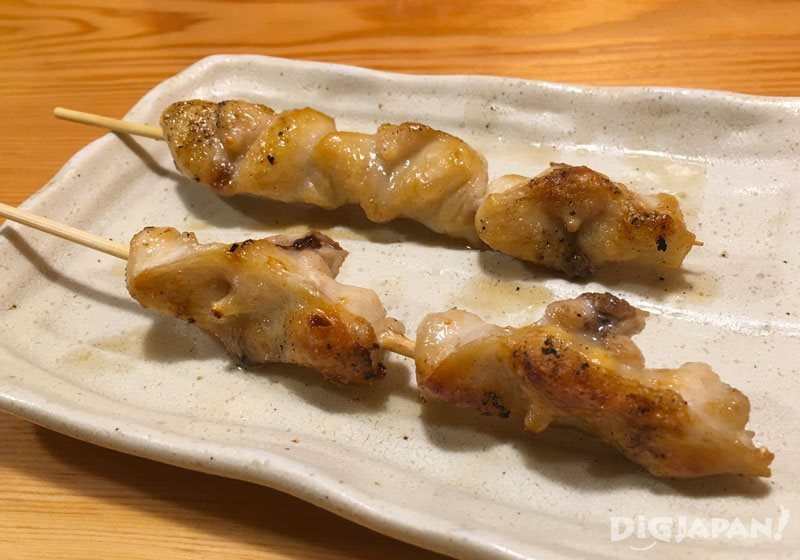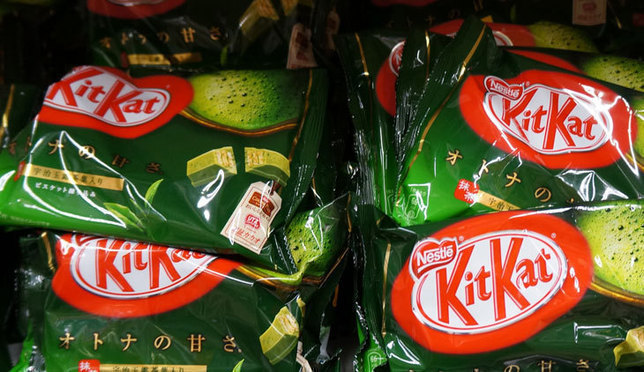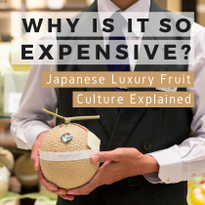- TOP
- Search Criteria
- A Beginner's Guide to Yakitori

STORY
Choose Your Chicken: a Beginner's Guide to Yakitori
Yakitori. This seemingly simple dish of bite-sized pieces of chicken grilled on wooden skewers is on its way to becoming the next hit food from Japan after sushi and ramen, but you’re lucky enough to try it during your trip to Japan. While wandering around, you see a man grilling skewers of delicious looking chicken over glowing charcoals and you know you've found your dinner.
The lack of an English menu doesn't bother you. You consider yourself an adventurous eater, and it's just chicken, right? You order by pointing to some things on the menu and sip on a beer as you wait. But when your yakitori arrives, you’re a little concerned. It doesn’t look much like chicken at all. What did I order...?
Whether you’re going to an izakaya or a yakitori-ya (a restaurant specializing in yakitori), most offer many more options than just familiar cuts of chicken like breast, thigh, and wing. In this guide, we’ll take you through some of the most common types of yakitori including how they’re normally written in Japanese, how to say them, and what part of the chicken they come from.
Negima
What it is: usually breast or thigh meat with pieces of naganegi onion
How you say it: neh-gee-mah
How it’s usually written: ネギマ or ねぎ間
In the world of yakitori, the negima is a classic. Bite-sized pieces of a type of long, thick spring onion called a naganegi (lit. long onion) are threaded onto the skewer between pieces of either breast or thigh meat. The negima pictured here is seasoned with salt.
Momo
What it is: thigh meat
How you say it: moh-moh
How it’s usually written: もも or モモ
Another good choice for those looking something simple yet delicious. You might be surprised at how grilling the meat yakitori-style brings out a whole new range of flavors. Try it seasoned with tare as pictured here to enjoy some Japanese-style barbecue chicken.
Tebasaki
What it is: chicken wing
How you say it: teh-ba-sah-key
How it’s usually written: 手羽先
A Japanese-take on a familiar favorite. You can’t go wrong with chicken wings. Whether or not these come on a skewer depends on the restaurant.
Sasami
What it is: meat from either side of the breast
How you say it: sah-sah-me
How it's usually written: ささみ
This tender cut of meat comes from either side of the breast bone. It is naturally low in fat and has a very mild flavor. Some yakitori restaurant will serve sasami with wasabi and beefsteak leaves for a flavor experience that is described as sappari or clean and refreshing. Tare would be a good option for those who prefer bolder flavors. The yakitori pictured here is flavored with salt.
Kawa
What is it: chicken skin
How you say it: kah-wah
How it’s usually written: 皮 or かわ
This is a great option for those looking for yakitori with a big, rich taste. The skin becomes crispy when grilled, but still retains a good amount of tasty fat. The skin used for yakitori is typically taken from the neck of the chicken. The kawa pictured here is flavored with salt, but tare is also a delicious choice.
Tsukune
What is it: chicken meat balls
How you say it: ts-koo-neh
How it’s usually written: つくね
In general, tsukune are chicken meatballs made using a basic recipe of ground chicken, egg, and potato starch. However, the exact recipe depends on the restaurant. For example, some restaurants will add finely chopped pieces of cartilage to the mix, giving the meatball a crunchy texture. In addition to tare and shio, some restaurants may serve their tsukune with a raw egg yolk for dipping.
Seseri
What it is: chicken neck meat
How you say it: seh-seh-ree
How it’s usually written: せせり or セセリ
Chicken neck meat has a decent amount of fat, making it a particularly juicy cut. Because the neck of the chicken is almost constantly moving, this piece also has a strong umami flavor without being gamey. While the meat is tender, there is a bit of cartilage-like crisp to some of the pieces. The seseri pictured here is flavored with salt.
Bonjiri / sankaku
What is it: chicken tail meat
How you say it: bon-gee-ree or san-kah-koo
How it’s usually written: ぼんじり or 三角
Tail meat is among the fattiest cuts of meat from a chicken. It is extremely juicy and usually has a melt-in-your-mouth texture. However, there is a little bit of cartilage-y crunch to a portion of it as well. This cut may also be written as テール, the phonetic Japanese spelling for the English word "tail" (te-ru). The tail pictured here is flavored with salt.
Nankotsu
What is it: grilled cartilage
How you say it: nan-koh-tsu
How it’s usually written: ナンコツ or なんこつ
Not having a particularly strong flavor, grilled cartilage is popular for its unique crunchy texture. There are two varieties of cartilage that are commonly served: that which connects thigh and shin muscle (pictured here) and that which comes before the breast bone (called yagen nankotsu). As a personal aside, I was not a fan of this yakitori when I first tried it. However, in time I grew to like it. Give it a chance.
Kimo / reba
What is it: chicken livers
How you say it: key-mo or reh-ba-a
How it’s usually written: きも or レバー
While almost all other meats can be compared to the taste of chicken, chicken liver doesn't actually taste much like chicken. It has a meaty, musky, even gamey taste and a smooth, almost creamy texture. It's hard to say whether you will like it without trying it (I personally love it), so definitely give it a go.
Hatsu / hato
What it is: chicken hearts
How you say it: hah-tsuu or ha-a-to
How it's usually written: ハツ, はつ, or ハート
Hearts also have a very meaty flavor, though not as strong as liver, and are surprisingly tender. My personal recommendation is to enjoy these with salt as pictured here.
Sunagimo
What is it: gizzard
How you say it: sue-nah-gee-moh
How it’s usually written: 砂肝
Before you write this one off as too weird, keep in mind that chicken gizzards are a popular food all over the world from Mexico to Hungary to even some parts of the United States. Sunagimo has a unique, crisp texture and a mild flavor. The sunagimo pictured here are flavored with salt.

As you order more and more yakitori, you may wonder what to do with the growing number of skewers. There should be a small container on your table. This is for the used skewers. Unlike empty glasses and plates which the staff will take away for you, the used skewers will hang out here until the end of your meal.
Do you have a favorite kind of yakitori, or a place you'd recommend for eating it? Let us know in the comments!
The lack of an English menu doesn't bother you. You consider yourself an adventurous eater, and it's just chicken, right? You order by pointing to some things on the menu and sip on a beer as you wait. But when your yakitori arrives, you’re a little concerned. It doesn’t look much like chicken at all. What did I order...?
Whether you’re going to an izakaya or a yakitori-ya (a restaurant specializing in yakitori), most offer many more options than just familiar cuts of chicken like breast, thigh, and wing. In this guide, we’ll take you through some of the most common types of yakitori including how they’re normally written in Japanese, how to say them, and what part of the chicken they come from.
A note about seasonings
Yakitori typical comes with two seasoning options: shio (salt) or tare (a sweet-savory sauce). You will often be able to choose which seasoning you want, but some establishments will have set pairings. Also, some will also offer other seasoning options like their own blend of spices or wasabi for certain kinds of yakitori.Beginner-friendly yakitori
The following yakitori are great when you want to play it safe with something familiar yet delicious.Negima

What it is: usually breast or thigh meat with pieces of naganegi onion
How you say it: neh-gee-mah
How it’s usually written: ネギマ or ねぎ間
In the world of yakitori, the negima is a classic. Bite-sized pieces of a type of long, thick spring onion called a naganegi (lit. long onion) are threaded onto the skewer between pieces of either breast or thigh meat. The negima pictured here is seasoned with salt.
Momo

What it is: thigh meat
How you say it: moh-moh
How it’s usually written: もも or モモ
Another good choice for those looking something simple yet delicious. You might be surprised at how grilling the meat yakitori-style brings out a whole new range of flavors. Try it seasoned with tare as pictured here to enjoy some Japanese-style barbecue chicken.
Tebasaki

What it is: chicken wing
How you say it: teh-ba-sah-key
How it’s usually written: 手羽先
A Japanese-take on a familiar favorite. You can’t go wrong with chicken wings. Whether or not these come on a skewer depends on the restaurant.
Sasami

What it is: meat from either side of the breast
How you say it: sah-sah-me
How it's usually written: ささみ
This tender cut of meat comes from either side of the breast bone. It is naturally low in fat and has a very mild flavor. Some yakitori restaurant will serve sasami with wasabi and beefsteak leaves for a flavor experience that is described as sappari or clean and refreshing. Tare would be a good option for those who prefer bolder flavors. The yakitori pictured here is flavored with salt.
Kawa

What is it: chicken skin
How you say it: kah-wah
How it’s usually written: 皮 or かわ
This is a great option for those looking for yakitori with a big, rich taste. The skin becomes crispy when grilled, but still retains a good amount of tasty fat. The skin used for yakitori is typically taken from the neck of the chicken. The kawa pictured here is flavored with salt, but tare is also a delicious choice.
Intermediate-level yakitori
These next yakitori are perfect for diners looking to try something a little more unusual without going overboard.Tsukune

What is it: chicken meat balls
How you say it: ts-koo-neh
How it’s usually written: つくね
In general, tsukune are chicken meatballs made using a basic recipe of ground chicken, egg, and potato starch. However, the exact recipe depends on the restaurant. For example, some restaurants will add finely chopped pieces of cartilage to the mix, giving the meatball a crunchy texture. In addition to tare and shio, some restaurants may serve their tsukune with a raw egg yolk for dipping.
Seseri

What it is: chicken neck meat
How you say it: seh-seh-ree
How it’s usually written: せせり or セセリ
Chicken neck meat has a decent amount of fat, making it a particularly juicy cut. Because the neck of the chicken is almost constantly moving, this piece also has a strong umami flavor without being gamey. While the meat is tender, there is a bit of cartilage-like crisp to some of the pieces. The seseri pictured here is flavored with salt.
Bonjiri / sankaku

What is it: chicken tail meat
How you say it: bon-gee-ree or san-kah-koo
How it’s usually written: ぼんじり or 三角
Tail meat is among the fattiest cuts of meat from a chicken. It is extremely juicy and usually has a melt-in-your-mouth texture. However, there is a little bit of cartilage-y crunch to a portion of it as well. This cut may also be written as テール, the phonetic Japanese spelling for the English word "tail" (te-ru). The tail pictured here is flavored with salt.
Yakitori for more ambitious eaters
These next yakitori primarily fall into the category of naizo or internal organs. While this may be uncharted territory for many diners, you might be surprised at just how good these yakitori are!Nankotsu

What is it: grilled cartilage
How you say it: nan-koh-tsu
How it’s usually written: ナンコツ or なんこつ
Not having a particularly strong flavor, grilled cartilage is popular for its unique crunchy texture. There are two varieties of cartilage that are commonly served: that which connects thigh and shin muscle (pictured here) and that which comes before the breast bone (called yagen nankotsu). As a personal aside, I was not a fan of this yakitori when I first tried it. However, in time I grew to like it. Give it a chance.
Kimo / reba

What is it: chicken livers
How you say it: key-mo or reh-ba-a
How it’s usually written: きも or レバー
While almost all other meats can be compared to the taste of chicken, chicken liver doesn't actually taste much like chicken. It has a meaty, musky, even gamey taste and a smooth, almost creamy texture. It's hard to say whether you will like it without trying it (I personally love it), so definitely give it a go.
Hatsu / hato

What it is: chicken hearts
How you say it: hah-tsuu or ha-a-to
How it's usually written: ハツ, はつ, or ハート
Hearts also have a very meaty flavor, though not as strong as liver, and are surprisingly tender. My personal recommendation is to enjoy these with salt as pictured here.
Sunagimo

What is it: gizzard
How you say it: sue-nah-gee-moh
How it’s usually written: 砂肝
Before you write this one off as too weird, keep in mind that chicken gizzards are a popular food all over the world from Mexico to Hungary to even some parts of the United States. Sunagimo has a unique, crisp texture and a mild flavor. The sunagimo pictured here are flavored with salt.
Where to stick the skewers

As you order more and more yakitori, you may wonder what to do with the growing number of skewers. There should be a small container on your table. This is for the used skewers. Unlike empty glasses and plates which the staff will take away for you, the used skewers will hang out here until the end of your meal.
Do you have a favorite kind of yakitori, or a place you'd recommend for eating it? Let us know in the comments!

Liked this story? Like DiGJAPAN!
on Facebook for daily updates!
THIS ARTICLE IS BASED ON INFORMATION FROM 10 07,2016 Author:Rachael Ragalye






















NEW COMMENT | 0 COMMENTS
Open a DiGJAPAN!
account to comment.
Open a DiGJAPAN! Account